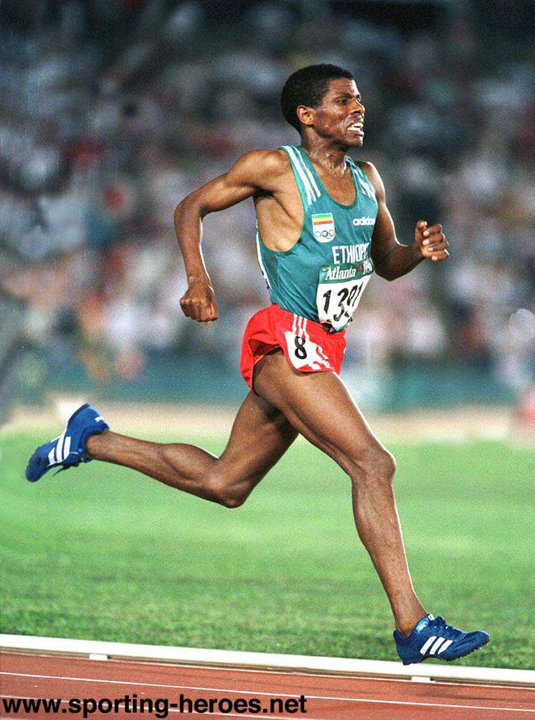1:59:40

Kenya’s Eliud Kipchoge has successfully completed the first ever marathon under two hours in the Austrian capital of Vienna, two years since he fell 25 seconds short.
The 34-year-old ran the 26.2 miles in 1 hour, 59 minutes and 40 seconds at Vienna’s Prater-Hauptallee (main avenue) — an achievement considered one of the ultimate milestones in athletic performance.
One of my favorite pieces of sportswriting is an essay that David Foster Wallace wrote about tennis. Wallace was a very good high school tennis player — as in the best player in his area — and he goes to watch a professional tournament, with a vague idea of maybe hitting around with one of the less celebrated pros at some point. (He ends up centering the essay on Michael Joyce, the 78th-ranked player in the world at the time, who has to play a qualifying tournament just to get into the main tournament):
A child’s world tends to be very small. If I’d been just a little bit better, an actual regional champion, I would have gotten to see that there were fourteen-year-olds in the United States playing a level of tennis unlike anything I knew about. My own game as a junior was a particular type of the classic defensive style, a strategy Martin Amis once described as “craven retrieval.” I didn’t hit the ball all that hard, but I rarely made unforced errors, and I was fast, and my general approach was simply to keep hitting the ball back to my opponent until my opponent fucked up and either made an unforced error or hit a ball so short and juicy that even I could hit a winner off it. It doesn’t look like a very glorious or even interesting way to play, now that I see it here in bald retrospective print, but it was interesting to me, and you’d be surprised how effective it was (on the level at which I was competing, at least). At age twelve, a good competitive player will still generally miss after four or five balls (mostly because he’ll get impatient or grandiose). At age sixteen, a good player will generally keep the ball in play for more like seven or eight shots before he misses. At the collegiate level, too, opponents were stronger than junior players but not markedly more consistent, and if I could keep a rally going to seven or eight shots, I could usually win the point on the other guy’s mistake [42]. I still play–not competitively, but seriously–and I should confess that deep down inside, I still consider myself an extremely good tennis player, very hard to beat. Before coming to Montreal to watch Michael Joyce, I’d seen professional tennis only on television, which, as has been noted, does not give the viewer a very accurate picture of how good pros are. I thus further confess that I arrived in Montreal with some dim unconscious expectation that these professionals–at least the obscure ones, the nonstars–wouldn’t be all that much better than I. I don’t mean to imply that I’m insane: I was ready to concede that age, a nasty ankle injury in 1988, and a penchant for nicotine (and worse) meant that I wouldn’t be able to compete physically with a young unhurt professional, but on TV (while eating junk and smoking), I’d seen pros whacking balls at each other that didn’t look to be moving substantially faster than the balls I’d hit. In other words, I arrived at my first professional tournament with the pathetic deluded pride that attends ignorance. And I have been brought up sharply. I do not play and never have played even the same game as these qualifiers.
One of the beauties of running is that you don’t have to go to a professional event to understand exactly what elite runners are doing. You can understand it, to the extent it’s understandable, just by putting on some running shoes and going out your front door.
A marathon is 26.2 miles or 42.2 kilometers.
Your local high school track is 400 meters. To run a 1:59:40 marathon, you would have to run around that track in 68 seconds. And you would have to do it 105 times consecutively.
It’s actually very difficult to run 400 meters in 68 seconds — even for most young athletic people, that’s faster than the pace they can reach in an all-out sprint, and nobody can maintain a sprint for more than about 25 seconds, since your body will demand that you slow down so you can metabolize some oxygen after that point.
So Kipchoge ran 26.2 miles (picture some place 26 miles from where you are now) at a far faster pace than the overwhelming majority of people can achieve for even 20 seconds.
Athletics have the virtue of being one of the very few areas of human performance in which achievement is usually more or less objectively measurable. This probably goes a long way toward explaining why, for example, white men do, comparatively speaking, a lot worse in athletic competition than they do in the ongoing social contest to find one of the tiny number of people who can write a good 10,000-world cover story for a major magazine.


